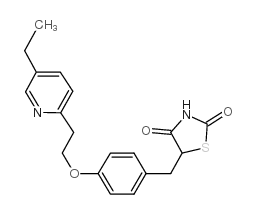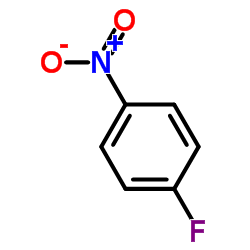112529-15-4
| Name | [5-[[4-[2-(5-Ethyl-2-pyridinyl)ethoxy]phenyl]methyl]-2,4-] thiazolidinedione hydrochloride |
|---|---|
| Synonyms |
Effects of pioglitazone
PIODLITAZONE HYDROCHLORIC Pioglitazonehydrochloride Pioglitazone hydrochloride 5-{4-[2-(5-Ethylpyridin-2-yl)ethoxy]benzyl}-1,3-thiazolidine-2,4-dione hydrochloride (1:1) MFCD04975446 Pioditazone hydrochloride 5-(4-(2-(5-Ethylpyridin-2-yl)ethoxy)benzyl)thiazolidine-2,4-dione hydrochloride 5-{4-[2-(5-ethylpyridin-2-yl)ethoxy]benzyl}-1,3-thiazolidine-2,4-dione hydrochloride 5-{4-[2-(5-Ethyl-2-pyridinyl)ethoxy]benzyl}-1,3-thiazolidine-2,4-dione hydrochloride 5-[4-[2-(5-Ethyl-2-pyridyl)ethoxy]benzyl]-2,4-thiazolidinedione Hydrochloride 5-[[4-[2-(5-Ethyl-2-pyridinyl)ethoxy]phenyl]methyl]-2,4-thiazolidinedione monohydrochloride 2,4-Thiazolidinedione, 5-[[4-[2-(5-ethyl-2-pyridinyl)ethoxy]phenyl]methyl]-, hydrochloride (1:1) UNII:JQT35NPK6C 5-{4-[2-(5-éthylpyridin-2-yl)éthoxy]benzyl}-1,3-thiazolidine-2,4-dione chlorhydrate 5-{4-[2-(5-Ethylpyridin-2-yl)ethoxy]benzyl}-1,3-thiazolidin-2,4-dionhydrochlorid Actos Pioglitazone HCl 5-{4-[2-(5-Ethyl-2-pyridinyl)ethoxy]benzyl}-1,3-thiazolidine-2,4-dione hydrochloride (1:1) Pioglitazone hydrochloride AD-4833 Pioglitazone (hydrochloride) |
| Description | Pioglitazone hydrochloride is a potent and selective PPARγ agonist with EC50s of 0.93 and 0.99 μM for human and mouse PPARγ, respectively. |
|---|---|
| Related Catalog | |
| Target |
PPARδ:0.01 μM (EC50, Human PPARδ) PPARα:0.93 μM (EC50, Human PPARα) PPARγ:43 μM (EC50, Human PPARγ) |
| In Vitro | AGEs-induced beta cell necrosis is completely abrogated by adding Pioglitazone to the AGEs culture medium. Furthermore Pioglitazone completely prevented any AGEs-induced increment in caspase-3 activation, thereby restoring caspase-3 activity to the same levels as the control cells. As expected AG is able to counteract AGEs-induced impaired viability[2]. |
| In Vivo | The serum-free fatty acid and triglyceride levels as well as adipocyte sizes in ob/ob and adipo-/- ob/ob mice are unchanged after 10 mg/kg Pioglitazone but are significantly reduced to a similar degree after 30 mg/kg Pioglitazone. Moreover, the expressions of TNFα and resistin in adipose tissues of ob/ob and adipo-/- ob/ob mice are unchanged after 10 mg/kg Pioglitazone but are decreased after 30 mg/kg Pioglitazone. Thus, Pioglitazone-induced amelioration of insulin resistance and diabetes may occur adiponectin dependently in the liver and adiponectin independently in skeletal muscle[3]. Pioglitazone (10 mg/kg per d) treatment significantly attenuates the loss of body weight (BW) and cardiac hypertrophy. Pioglitazone treatment significantly reduces the elevated serum glucose levels and markedly improved the associated dyslipidemia. Furthermore, there is a slight but significant increase in serum creatinine level in D rats over their N controls (P <0.05). However, a marked renal dysfunction is observed in diabetic nephropathic (DN) group (P<0.05). Moreover, DN rats exhibits the highest serum activity of CK-MB, relative to both N and D rats (P<0.05). Pioglitazone is able to decrease the elevated serum levels of both creatinine and creatine kinase-MB (CK-MB)[4]. |
| Cell Assay | In order to evaluate cell proliferation, HIT-T15 cells are seeded on 96-well plates (3×104 cells/well) and cultured for 5 days as described. Viable cells are determined using the Cell Titer 96 Aqueous One Solution Cell Proliferation Assay. To evaluate cell apoptosis and cell necrosis, HIT-T15 cells are plated on 6-well dishes (7×105 cells/well) for 5 days in standard conditions (CTR) or in the presence of AGEs (AGEs) with or without Pioglitazone (0.5 or 1 μM) or AG (1 mM). They are then processed to measure both the activity of caspase-3 and the activity of lactate dehydrogenase (LDH) (a stable cytosolic enzyme that is a marker of cell membrane damage and cell death due to necrosis) using Cytotox 96 Non Radioactive Cytotoxicity Assay[2]. |
| Animal Admin | Mice[3] 10 mg/kg Pioglitazone HCl or vehicle (0.25% carboxymethylcellulose) is adnimistered to ob/ob and adipo-/- ob/ob mice by oral gavage once daily for 14 consecutive days. 30 mg/kg Pioglitazone or vehicle is also adnimistered to ob/ob and adipo-/- ob/ob mice by oral gavage once daily for 14 consecutive days. Rats[4] Male Wistar albino rats (weighing 250±20 g) are ued.Rats that achieved serum glucose level ≥250 mg/dL and serum creatinine level ≥1.5 mg/dL are divided into 2 groups (n=10 per each group): diabetic nephropathic (DN) group in which rats received an equal amount of vehicle (0.5% carboxy methyl cellulose) and Pioglitazone-treated (DN+Pio) group in which rats treated with Pioglitazone. Pioglitazone (10 mg/kg BW) is given orally by gastric gavage, once daily, for 4 weeks. |
| References |
| Density | 1.26 g/cm3 |
|---|---|
| Boiling Point | 575.4ºC at 760 mmHg |
| Melting Point | 193-194ºC |
| Molecular Formula | C19H21ClN2O3S |
| Molecular Weight | 392.900 |
| Flash Point | 301.8ºC |
| Exact Mass | 392.096130 |
| PSA | 93.59000 |
| LogP | 4.29040 |
| Vapour Pressure | 0mmHg at 25°C |
| Index of Refraction | 1.64 |
| Storage condition | Desiccate at RT |
| Symbol |

GHS07 |
|---|---|
| Signal Word | Warning |
| Hazard Statements | H319 |
| Precautionary Statements | P305 + P351 + P338 |
| Hazard Codes | Xi:Irritant |
| Risk Phrases | R36/38 |
| Safety Phrases | 22-24/25 |
| RIDADR | NONH for all modes of transport |
| HS Code | 2933990090 |
| Precursor 9 | |
|---|---|
| DownStream 3 | |
| HS Code | 2933990090 |
|---|---|
| Summary | 2933990090. heterocyclic compounds with nitrogen hetero-atom(s) only. VAT:17.0%. Tax rebate rate:13.0%. . MFN tariff:6.5%. General tariff:20.0% |



![2-bromo-3-{4-[2-(5-ethylpyridin-2-yl)ethoxy]phenyl}propionic acid structure](https://image.chemsrc.com/caspic/092/674798-32-4.png)


![N-(5-{4-[2-(5-ethyl-pyridin-2-yl)ethoxy]benzyl}-4-oxo-4,5-dihydrothiazol-2-yl)-4-methylbenzenesulfonamide structure](https://image.chemsrc.com/caspic/467/1034515-24-6.png)
![5-{4-[2-(5-Ethyl-2-pyridinyl)ethoxyl]benzylene}-2,4-thiazolidinedione structure](https://image.chemsrc.com/caspic/443/144809-28-9.png)
![5-Ethyl-2-[2-(4-nitrophenoxy)ethyl]pyridine structure](https://image.chemsrc.com/caspic/398/85583-54-6.png)


![(2S,3S,4S,5R,6R)-6-[5-[[4-[2-(5-ethylpyridin-2-yl)ethoxy]phenyl]methyl]-2,4-dioxo-1,3-thiazolidin-3-yl]-3,4,5-trihydroxyoxane-2-carboxylic acid structure](https://image.chemsrc.com/caspic/118/1296832-75-1.png)

